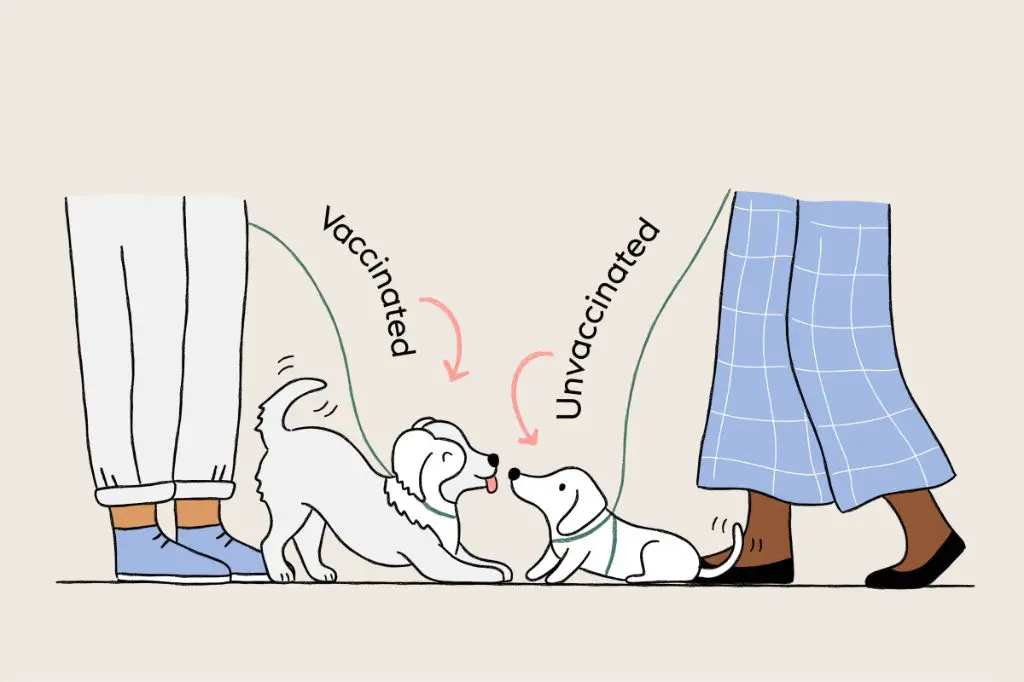Introduction
Rabies is a dangerous viral disease that affects the central nervous system and is almost always fatal once symptoms appear. Rabies is primarily spread through bites and scratches from infected animals, most commonly dogs. According to the CDC, rabies kills over 59,000 people worldwide each year. In the United States, human deaths from rabies are rare thanks to widespread pet vaccination programs and availability of post-exposure treatment. However, every year there are several thousand cases of rabies found in wild animals and unvaccinated pets across the U.S.
To prevent the spread of rabies and protect public health, the vast majority of U.S. states and local jurisdictions have laws requiring routine vaccination of dogs. However, questions remain over how well these laws are enforced and what percentage of the total U.S. dog population is currently vaccinated against rabies.
Rabies Vaccine Laws by State
Rabies vaccination laws vary by state, but all 50 states have laws requiring dogs, cats, and ferrets to be vaccinated against rabies. According to the CDC, rabies vaccination is required for dogs in all states, cats in 45 states and the District of Columbia, and ferrets in 20 states. Here is a summary of state laws requiring rabies vaccination:

All 50 states require rabies vaccination for dogs. Some states require vaccination as early as 3 months of age, while others require it by 4-6 months of age. Most states require that dogs receive a booster 1 year after the initial vaccination, and every 1-3 years thereafter. Some states allow exemptions for dogs that never leave the owner’s premises and have no contact with other animals (Table of State Rabies Vaccine Laws for Companion Animals).
45 states and Washington D.C. require rabies vaccination for cats. The age requirements are similar to dogs, with most states requiring vaccination by 3-6 months of age. As with dogs, most states require a booster 1 year after the initial vaccine and every 1-3 years thereafter. Some states allow exemptions for indoor-only cats.
At least 20 states require rabies vaccination for ferrets, beginning around 3-4 months of age. Boosters are required annually in most of these states (Ways Cats Can Enjoy the Outdoors Safely).
Enforcement of Rabies Laws
Enforcement of rabies laws and vaccination requirements varies by jurisdiction in the United States. According to the National Association of State Public Health Veterinarians (NASPHV), each state health department should designate a Rabies Control Authority (RCA) responsible for enforcing rabies laws and ordinances locally.
RCAs are typically animal control officials, public health veterinarians, or other public health officials designated by the state health department. RCAs work to ensure pet owners comply with rabies vaccination and licensing laws. They also enforce protocols for handling rabies exposures and humanely euthanizing animals with confirmed rabies. RCAs have the authority to issue citations or quarantine animals when rabies laws are violated.
According to a Kitsap Public Health advisory, penalties for violating rabies laws range from civil infractions to criminal misdemeanors punishable by fines and even jail time (https://kitsappublichealth.org/CommunityHealth/files/20160328_Animals_Exposed_to_Rabies_Advisory.pdf). However, enforcement varies. Some areas strictly enforce laws, while other places have lax enforcement. Overall, most states have rabies regulations in place, but compliance depends on local authorities.
Vaccination Rates
According to the CDC, despite rabies vaccination laws, not all dogs in the US are properly vaccinated against rabies. The CDC reports that around 60-70 dogs and more than 250 cats are diagnosed with rabies each year in the US. Nearly all of these animals were unvaccinated when they acquired rabies (CDC).

A 2021 study found that while most veterinarians are often successful in convincing dog and cat owners to vaccinate against rabies, some still face resistance. Veterinarians estimated that they successfully convinced 63.3% of dog owners and 57.3% of cat owners who were hesitant about rabies vaccination (Kogan et al.).
This indicates that while rabies vaccination rates for dogs are high, there are still a substantial number of dogs that remain unvaccinated despite rabies vaccine laws.
Barriers to Vaccination
There are several barriers that may prevent some dogs in the U.S. from receiving the rabies vaccine as required by law:
Cost – The rabies vaccine costs around $15-20 per dose. For pet owners facing financial hardship, this cost may be prohibitive. Some low-cost vaccination clinics are available but limited.
Lack of Access – Pet owners without reliable transportation may struggle to bring their dogs into a vet clinic or vaccination event. Rural areas with fewer clinics also reduce access.
Misinformation – Anti-vaccine misinformation circulating online can lead some owners to refuse vaccinations for their dogs. Some may falsely believe vaccines are unnecessary or dangerous.
Fear – Some dogs are fearful or anxious around strangers and react negatively to vet visits. Their owners may avoid vaccinating them as a result.
Irresponsibility – A minority of pet owners fail to properly care for their dogs by neglecting to keep them vaccinated as required by law.
While rabies vaccination rates are generally high nationwide, these barriers can lead to pockets of unvaccinated dogs, putting communities at increased risk.
Consequences of Non-Vaccination

There are significant health and legal risks associated with not vaccinating dogs against rabies according to laws and regulations. Rabies is almost always fatal once clinical signs appear, and vaccination is the most effective method for preventing the spread of the disease (NPR). If an unvaccinated dog is exposed to a rabid animal and develops rabies, the dog will likely die. Additionally, the dog can transmit rabies to humans through bites or saliva, which almost always leads to death in humans unless treated immediately with rabies post-exposure prophylaxis.
Legally, dogs are required to be vaccinated for rabies according to local and state laws. An owner who does not vaccinate their dog can face fines, impoundment of the animal, and criminal charges if the unvaccinated dog exposes others. Rabies vaccination exemptions are possible but limited. Failure to vaccinate also leads to restrictions on licensing, public access, and travel (AVMA). The health and legal consequences underscore the importance of adhering to rabies vaccination requirements.
Vaccine Exemptions
While rabies vaccination laws are strict in most states, exemptions are possible in certain situations.
Medical exemptions can be granted if a licensed veterinarian examines the dog and provides a written statement that the rabies vaccine would endanger the dog’s health because of disease, pregnancy, or other medical considerations (12VAC5-105-30, Loudoun County).
Some states allow exemptions for dogs with immune-mediated diseases that would make vaccination unsafe, according to the American Animal Hospital Association’s canine vaccination guidelines.
Religious exemptions are permitted in some states if rabies vaccination conflicts with the owner’s religious beliefs, though this type of exemption is less common.
Other types of exemptions occasionally granted include animals too old to respond to vaccination, dogs not at risk for exposure, or dogs living in remote areas with low rabies risk (Loudoun County).
Exemptions usually require annual renewal along with documentation from a veterinarian. Local health departments make the final determination on granting exemptions.
Importance of Herd Immunity
Herd immunity is when a large portion of the population is immune to a disease, making it difficult for the disease to spread. This provides indirect protection to those who are not immune. High vaccination rates are crucial for establishing herd immunity against rabies in the dog population.
According to a study published in the Jurnal Veteriner, when vaccination rates reach 70% or higher in a region, unvaccinated dogs gain substantial protection from rabies outbreaks [1]. The vaccinated dogs act as a barrier to transmission, as rabies struggles to spread among immune dogs. This makes it less likely for the virus to reach unvaccinated or undervaccinated dogs.

Maintaining herd immunity is vital, as rabies is almost always fatal once clinical signs appear. The high contagiousness also means an outbreak can spread rapidly. Widespread vaccination protects each dog and the overall population.
Conclusion
While rabies vaccination laws exist in every U.S. state, not every dog is necessarily vaccinated against this deadly disease. Enforcement and compliance varies by location. Overall, rabies vaccination rates for dogs range from 75-85%, with some areas reporting lower levels. Reasons for lack of vaccination include inability to afford vet care, not seeing it as a priority, and belief in vaccine exemptions. However, failure to vaccinate dogs against rabies puts communities at risk due to the rapid spread of the virus. To protect public health and prevent further spread, it is critical to vaccinate as many dogs as possible.
In summary, no, not all dogs in the U.S. are vaccinated for rabies, although the vast majority are. Work remains to be done to increase compliance with vaccination laws and ensure herd immunity against this dangerous disease. But the existence of rabies vaccine mandates in every state demonstrates an understanding of the importance of protecting animal and human health through vaccination.
References
[1] Center for Disease Control and Prevention. “Rabies: Domestic Animals.” 2022.
[2] Rabies.org. “Rabies Laws, Rules, Regulations & Ordinances by State.” 2022.
[3] Dyer, Kelly. “An overview of rabies elimination efforts in North America.” The Veterinary Journal. 2017.
[4] Brosch, Ronald et al. “The rise and fall of rabies in Japan: A quantitative history of rabies epidemics in Osaka Prefecture, 1914–1933.” Proceedings of the Royal Society B: Biological Sciences. 2002.
[5] Jones, Kate E et al. “Global trends in emerging infectious diseases.” Nature. 2008.